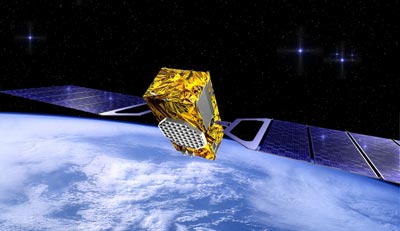What will Galileo cost?by Taylor Dinerman
|
| The problem is that there is no credible business plan to insure that the companies that make up the consortia would recover the capital they put in, let alone make a reasonable return on investment. |
If finished as planned, the European satellite navigation constellation will ultimately be composed of thirty satellites and the associated ground segment. It has been claimed that, when it becomes operational, it will be more accurate and more reliable than the American GPS. After the initial funding from the EU and from ESA is used up, it is supposed to be financed in large part by private industry.
There were supposed to be two rival consortia bidding for the privilege of building and operating the system. The news that these two rivals may decide to merge is significant. Something does not seem to be working and behind the scenes ESA and the EU must be negotiating hard to keep the program on track.
As of last December, the plan was for the follow-on phase, costing €2.1 billion (US$2.7 billion), to be two-thirds paid for by private industry. The problem is that there is no credible business plan to insure that the companies that make up the consortia would recover the capital they put in, let alone make a reasonable return on investment. The only credible scheme so far is the idea floating around that carmakers would be forced to put tracking devices using Galileo technology in all new cars sold in the EU. The consortium would receive a percentage of the fines levied on traffic violations detected with the assistance of the system.
The resistance to similar schemes involving stoplights in the US would indicate that such a scheme would run up against feelings of frustration with the EU. At a time when the populations of member states such as France are, according to polls, rejecting the proposed EU constitution, do EU leaders really want to tell the citizens of the continent that they are going to have yet another one of their rapidly-diminishing freedoms reduced yet again?
In any case, putting a full thirty-satellite constellation with the proposed capabilities into orbit will certainly cost far more than 4 billion euros. One only has to look at how much the Pentagon spends on the care and feeding of GPS to realize this.
In 2004, the Department of Defense spent $234 million on GPS R&D. This year it will spend $289 million and next year they are asking for $401 million. The US is going to be spending more than $900 million in R&D alone on a system that has been fully operational for more than a decade. This is on top of another $900 million that will be spent on the procurement of the actual hardware and software. According to one published source, GPS cost between $10 and $11 billion between 1987 and 2002. For this, the US military gets a state-of-the-art updated, and fairly robust, satellite navigation capability.
| Galileo is now more of a political talisman than a genuine effort to develop breakthrough technology. |
This comes on top of a decades-long program that began in the early seventies. The first GPS satellite was launched in 1978. For the Europeans to imagine that they can jump in, and provide a similar—or better—set of navigation signals for less than half of the price the US has paid seems dubious at best. The presence of major US defense contractors, such as Boeing and Lockheed Martin, inside the industrial consortia would indicate that Galileo will not, as advertised, “emancipate” Europe from its technological dependence on America.
Galileo is now more of a political talisman than a genuine effort to develop breakthrough technology. As a military system, it will be vulnerable to attack unless it is equipped with expensive and elaborate active defensive measures. As a source of industrial expertise, it would seem to be yet another European effort to master yesterday’s technology. The only reasons left are solely political. While governments may find it easy to spend taxpayer funds on projects that bring them prestige, it is hard to imagine businessmen who are—theoretically—interested in profit investing in such a scheme.
Unless there is something else going on, Europe’s major aerospace firms are even more closely tied to their governments than are those of the US. So it is easy to imagine that the leaders of such companies, like EADS, are trying to negotiate deals whereby they would be compensated for investing their stockholders’ money in Galileo in other, indirect, ways. Unless the financing of Galileo is done in a fully transparent fashion, it will almost inevitably become the subject of yet another bitter US-EU aerospace trade dispute.
